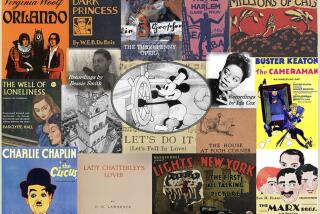Inventors Enlist Rohrabacher in Patent Life Battle : Congress: The O.C. lawmaker wants to thwart a global trade pact provision that shortens the time creators can hold exclusive rights.
WASHINGTON — Tucked away in the thousands of pages of a worldwide trade agreement is a little-noticed provision that has become Rep. Dana Rohrabacher’s passion in the new Congress.
Rohrabacher (R-Huntington Beach) has been cornering his colleagues to convince them that the matter will cost U.S. inventors millions of dollars that will ultimately land in the pockets of foreign companies and multinational corporations.
An array of inventors--from the man who created kitty litter to the inventor of the magnetic resonance imaging scanner--have enlisted Rohrabacher to thwart a provision that would shorten the length of time a person can hold exclusive rights to his or her invention.
Rohrabacher, a former editorial writer who is working on a book, said he felt somebody had to step up to fight for the creative voices behind inventions that save lives or make everyday tasks easier.
“As a writer, I’ve always noted that creative people are taken for granted,” Rohrabacher said Friday. “I think this whole patent issue is an example of how creative people are stepped on by the upper levels.”
No other issue has taken up as much of his time so far this year, Rohrabacher said.
The congressman has enlisted the support of Senate Majority Leader Bob Dole (R-Kan.) and more than one-fourth of the House of Representatives. But Rohrabacher’s first hurdle is convincing a fellow Southern California Republican to support the measure.
The work started last year when Rohrabacher tried to have a section removed from the General Agreement on Tariffs and Trade, a worldwide trade agreement Congress approved in December.
The provision would change a 150-year-old law that gives inventors the rights to their creations for 17 years after the patent application is approved. The GATT requirement would extend the period to 20 years from the date the application is filed.
But because of sometimes lengthy delays by the U.S. Patent and Trademark Office, inventors say the change would shorten the time their patent is valuable and deprive them of royalties.
For example, if a patent application takes 10 years to process, the inventor has only 10 more years at that point to make money from the creation. Under the old system, the inventor would have 17 more years to earn royalties.
However, some inventors say the new system is necessary to prevent “submarine patents,” in which an inventor applies for a patent but purposely delays its approval through amendments.
As soon as a market develops for the product and another company begins producing it, the inventor’s patent is approved and he or she can immediately start collecting royalties from that company.
“It opens the door to unreasonably extending the life of the patent,” said Herbert Wamsley, executive director of the Intellectual Property Owners Assn. in Washington.
Rohrabacher said the opposition comes from Japanese companies, which want to shorten the length of time they have to pay royalties to U.S. inventors, and large corporations that are “users” of technology rather than “creators.”
*
“It means technology paid for and invented in the United States will in a few short years be available to our world competitors to use against us for free,” he said.
Charles Hall, a Northern California resident who invented the first water bed in 1968, said the time issue determines whether a person can make a living from inventing new products.
Because it takes time for new products to develop a following in the marketplace, most inventors don’t make money until years after they receive a patent. Hall said he didn’t earn royalties from the water bed until 1988.
Rohrabacher failed to have the measure removed from GATT. Many lawmakers agreed with his arguments, but few wanted to doom the entire trade pact for that issue, he said.
But he enlisted the help of Dole, who deemed the issue important enough to bring up with President Clinton last year. Dole had threatened to oppose the trade pact unless the White House agreed to series of demands, including dropping its opposition to Rohrabacher’s initiative. Clinton agreed.
On the first day of Congress this year, Rohrabacher introduced legislation to change the patent protection term to whichever time period is greater.
Through speeches on the House floor, letters and one-on-one conversations, the congressman has won the support of 116 House members, including more than 30 Democrats. Dole has sponsored a companion bill in the Senate.
*
But first Rohrabacher must sell Rep. Carlos Moorhead (R-Glendale) on the bill. Moorhead chairs the House Judiciary subcommittee through which the measure must pass. Several inventors lobbying for the bill said Moorhead has been unwilling to hold hearings on the measure.
Rohrabacher had scheduled a Friday meeting with Moorhead to ask him to convene hearings, but the meeting was canceled because of scheduling conflicts. Rohrabacher said he hopes to get Moorhead’s ear next week.
No one was available in Moorhead’s office to discuss his position.
In the meantime, inventors are rallying their colleagues to call Moorhead and other lawmakers and pressure them on the issue.
“This is the first time we’ve been organized,” said Ron Riley, a Michigan inventor. “Inventors are the incubators for new ideas, and we’re not staying quiet.”
(BEGIN TEXT OF INFOBOX / INFOGRAPHIC)
How Patents Work
Patent protection is granted in the United States on a first-to-invent basis, rather than a first-to-file basis. That system has sparked debate among legislators, who are seeking to reform the process. Here are some facts about the current patent system:
* What is a patent? It is a grant from the U.S. government that for 17 years gives an inventor the right to exclude others from making, using or selling an identical invention without permission.
* What can be patented? Machines, manufactured articles, a chemical composition or a process can all be patented. A prototype is not necessary. The invention must be “novel” and not obvious to qualify for protection.
* What makes an invention “novel”? A patent search is done to determine if the invention is the first of its kind. A description of the invention is researched to ensure that a patent does not exist for a similar one.
* How does a person get a patent? Once the invention is researched, the inventor may file an application with the U.S. Patent and Trademark Office. Applications must be filed within 12 months after the first description of the invention is published or after the first offer for its sale or public use is made in the United States.
Source: Price, Gess & Ubell, attorneys at law; Researched by VALERIE WILLIAMS-SANCHEZ / Los Angeles Times.
More to Read
Inside the business of entertainment
The Wide Shot brings you news, analysis and insights on everything from streaming wars to production — and what it all means for the future.
You may occasionally receive promotional content from the Los Angeles Times.










